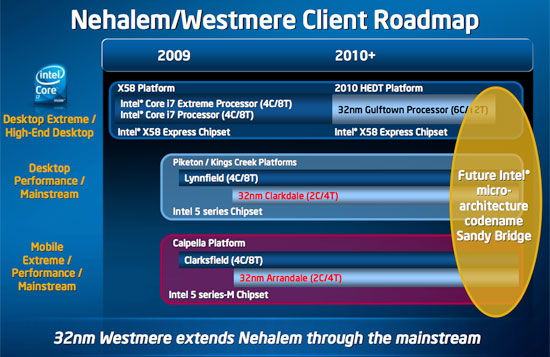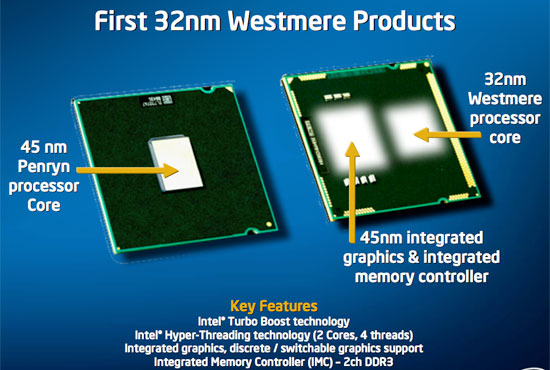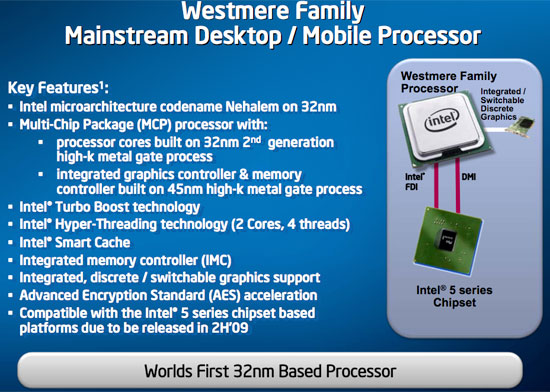Intel's 32nm Update: The Follow-on to Core i7 and More
by Anand Lal Shimpi on February 11, 2009 12:00 AM EST- Posted in
- CPUs
Enter the 32nm Lineup
Instead of Havendale in Q4, we’ll get Clarkdale and Arrandale. These are both dual-core, quad-thread processors, and both have on-package graphics. The CPU cores will be built on Intel’s 32nm process and in fact, they will be the first Westmere CPUs shipping into the market.

Now note that the dual-core market is the largest slice of the processor pie. Intel must be incredibly confident in its 32nm process to start shipping it into these demand markets first. Remember that both 65nm and 45nm initially launched on the high end desktop, but 32nm is making its debut in mainstream notebooks and desktops. The 32nm ramp is going to be a good one folks.
| Segment | Manufacturing Process | Socket | Processor | Cores | Threads | Release Date |
| High End Desktop | 32nm | LGA-1366 | Gulftown | 6 | 12 | 1H 2010 |
| Mainstream Desktop | 32nm | LGA-1156 | Clarkdale | 2 | 4 | Q4 2009 |
| Mobile | 32nm | mPGA-989 | Arrandale | 2 | 4 | Q4 2009 |
| 4S Server | 32nm | LGA-1567 | ??? | ? | ? | 2010 |
| 2S Server | 32nm | LGA-1366 | ??? | ? | ? | 2010 |
| 1S Server | 32nm | LGA-1156 | Clarkdale | 2 | 4 | 2010 |
Clarkdale/Arrandale have 32nm CPUs but their on-package GPUs are still built on Intel’s 45nm process; these are the GPUs that were supposed to be used for Havendale! It won’t be until 2010 with Sandy Bridge that we see a 32nm CPU and 32nm GPU on the same package.

A side effect of the Clarkdale/Arrandale architecture is that the memory controller is now located on the GPU and not the CPU, although both are still on package and should still be quite low latency.

Keep following; if you want a quad-core Westmere, your only option will be in the LGA-1366 socket with Gulftown. Core i7 will get replaced with a six-core, twelve-thread processor in early 2010. There won’t be a 32nm quad-core part on the desktop until the end of 2010 with Sandy Bridge.










64 Comments
View All Comments
Targon - Wednesday, February 11, 2009 - link
For the CPU market, the problem is the ever growing amount of cache memory. Intel processors are designed with the large cache being their solution to improvements that AMD brings to the table.I suspect that Intel will have more trouble after this move to the new fab process because the difficulty in moving to a new process node grows at an exponential rate. We saw Intel hit a wall with the Pentium 3 line because they were not ready for a new process shrink at that point, so the P4 came out. When Intel got their process technology on track, the people at Intel could go back to the Pentium 3 design(with improvements) to release the Core and Core 2 Duo.
There will come a time when an all new design will be needed in order to hold on to their lead, and that is when AMD will probably catch back up, if AMD can survive until then.
BSMonitor - Thursday, February 12, 2009 - link
What an utter load of BS. Thanks fanboy.You get all that from wiki?
PrinceGaz - Wednesday, February 11, 2009 - link
Even though my last three CPUs were all from AMD (they made sense at the time- K6-III/400, Athlon XP 1700+, Athlon 64 X2 4400+), I have to disagree with your comment about the improvements (presumably the integrated memory controller) which AMD brings to the table.With Core i7, Intel has effectively removed the one last technological advantage AMD had- faster memory access. The fact that Intel chips still tend to have larger L3 caches is quite simply because they can afford to give it to them, as they are ahead of AMD on the fab-process. For a high-end desktop chip where there is die-space to spare, you could add some more cores which will probably sit idle (keeping four busy is hard enough, especially with HT), but adding more L3 cache (so long as the latency of it is not adversely affected) is a very cheap and easy way to use up the space and provide a bit of a speedup in almost everything.
AMD is currently fighting a losing game. The Phenom II (bug-fixed Phenom) cannot compete with Core i7 with AMDs current fabs, and unlike Intel who have the tick-tock steady new-process, then new-design with large teams working on each step; AMD seem to have one team working on a new design, which has to be made to work with whichever process looks like the best option at the time.
We need AMD to survive for the x86 (or x64, who came up with that :p ) CPU market to be competitive, but I think the head of AMD is going to have to get into bed with the head of IBM, else they are doomed to fall ever further behind Intel in chip-design. The K10 is promising, but a long way off still, and AMD hasn't exactly been raking in the billions of dollars of profits recently to do that R&D. VIA have found an x86 CPU niche they can compete in, I fear that unless AMD pull an elephant out the hat with the K10, they'll have to slot in between VIA and Intel in providing CPUs specialising in a particular performance-sector, with Intel being the undisputed leader.
JonnyDough - Wednesday, February 11, 2009 - link
Well said. I concur.